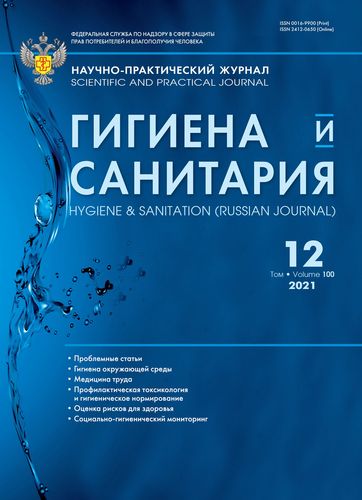Features of formation somatic pathologies under chronic exposure to hydrofluoride in the manufacture of titanic alloys
- Authors: Bazarova E.L.1,2,3, Fedoruk A.A.1, Osherov I.S.2, Roslaya N.A.3, Babenko A.G.2
-
Affiliations:
- Yekaterinburg Medical Research Center for Prophylaxis and Health Protection in Industrial Workers of Federal Service for Supervision in Protection of the Rights of Consumer and Man Wellbeing
- Private Healthcare Unit “Tirus”
- Ural State Medical University of the Russian Ministry of Health
- Issue: Vol 100, No 12 (2021)
- Pages: 1436-1442
- Section: OCCUPATIONAL HEALTH
- Published: 23.12.2021
- URL: https://edgccjournal.org/0016-9900/article/view/638731
- DOI: https://doi.org/10.47470/0016-9900-2021-100-12-1436-1442
- ID: 638731
Cite item
Full Text
Abstract
Introduction. Most studies on the morbidity of workers with fluorine compounds are devoted to occupational medicine at aluminium industry enterprises.
The aim of the study is to identify the exposure, gender and evolutionary features of the formation of general somatic morbidity associated with chronic occupational exposure to hydrofluoride in the production of titanium alloys.
Materials and methods. The analysis of the prevalence of chronic pathology according to the medical examination of 562 workers in contact with hydrofluoride and the incidence of temporary disability according to 29949 disability sheets in comparison with non-exposed persons of the same enterprise is given.
Results. With an increase in the degree of harmfulness of working conditions, there was an augmentation increase in the risk of developing pathology of the respiratory organs, eyes, musculoskeletal system, arterial hypertension and hypercholesterolemia. In the working conditions of Class 3.1, an increased prevalence of diseases of the nervous and genitourinary systems with a moderate degree of occupational conditionality was revealed (relative risks (RR) 1.6 and 2.0, respectively, р < 0.05), class 3.2 — a high degree of professional conditionality of respiratory diseases (RR = 2.8). When working in harmful working conditions, there was an average degree of occupational conditionality of nervous system diseases in women (RR = 1.9) and a small degree of arterial hypertension in men (RR = 1.2). The prevalence of general somatic pathology in all age groups was higher than in non-exposed persons of the same age.
Conclusion. Hydrofluoride in the production of titanium alloys was proved to be a trigger contributing to the formation of the pathology of the respiratory, circulatory, digestive, ear, eyes, skin, blood, musculoskeletal, nervous, endocrine, and genitourinary systems.
Conribution:
Bazarova E.L. — research concept and design, material collection and data processing, statistical processing, literature data collection, text writing;
Fedoruk A.A. — research concept and design, writing, editing;
Osherov I.S. — concept and design of the study;
Roslaya N.A. — writing text, editing;
Babenko A.G. — material collection and data processing, statistical processing.
All authors are responsible for the integrity of all parts of the manuscript and approval of the manuscript final version.
Conflict of interest. The authors declare no conflict of interest.
Acknowledgement. The study had no sponsorship.
Received: November 11, 2021 / Accepted: November 25, 2021 / Published: December 30, 2021
About the authors
Ekaterina L. Bazarova
Yekaterinburg Medical Research Center for Prophylaxis and Health Protection in Industrial Workers of Federal Service for Supervision in Protection of the Rights of Consumer and Man Wellbeing; Private Healthcare Unit “Tirus”; Ural State Medical University of the Russian Ministry of Health
Author for correspondence.
Email: bazarova@vsmpo.ru
ORCID iD: 0000-0002-7377-6024
MD, PhD, doctoral student of the Yekaterinburg Medical Research Center for Prophylaxis and Health Protection in Industrial
Workers; docent of the Department of Hygiene and Ecology of the Ural State Medical University of the Russian Ministry of Health; occupational health physician of the Private Healthcare Unit “Tirus”; Verkhnyaya Salda, 624760, Russian Federation.
e-mail: bazarova@vsmpo.ru
Russian FederationAnna A. Fedoruk
Yekaterinburg Medical Research Center for Prophylaxis and Health Protection in Industrial Workers of Federal Service for Supervision in Protection of the Rights of Consumer and Man Wellbeing
Email: noemail@neicon.ru
ORCID iD: 0000-0002-6354-0827
Russian Federation
Ilya S. Osherov
Private Healthcare Unit “Tirus”
Email: noemail@neicon.ru
ORCID iD: 0000-0003-0408-4216
Russian Federation
Natalya A. Roslaya
Ural State Medical University of the Russian Ministry of Health
Email: noemail@neicon.ru
ORCID iD: 0000-0001-8907-0360
Russian Federation
Aleksey G. Babenko
Private Healthcare Unit “Tirus”
Email: noemail@neicon.ru
ORCID iD: 0000-0002-1424-6103
Russian Federation
References
- Federal Register of Potentially Dangerous Chemical and Biological Substances of Rospotrebnadzor. Hydrofluoric acid. Information card. Available at: https://www.rpohv.ru/online/detail.html?id=375 (in Russian)
- Fluorides: Environmental Health Criteria 227. Geneva: WHO; 2002.
- Roslaya H.A., Likhacheva I.E., Oranskiy I.E., Odinokaya V.V., Plotko E.G., Zhovtyak E.P., et al. Clinical and pathogenetic aspects of the chronic occupational intoxication with fluorine compounds in modern reality. Meditsina truda i promyshlennaya ekologiya. 2012; (11): 17–21. (in Russian)
- Izmerov N.F., Bukhtiyarov I.V., Prokopenko L.V., Kuzmina L.P., Sorkina N.S., Burmistrova T.B., et al. Modern aspects of preserving and strengthening the health of workers employed at aluminum production enterprises. Meditsina truda i promyshlennaya ekologiya. 2012; (11): 1–7. (in Russian)
- Song Y.E., Tan H., Liu K.J., Zhang Y.Z., Liu Y., Lu C.R., et al. Effect of fluoride exposure on bone metabolism indicators ALP, BALP, and BGP. Environ. Health Prev. Med. 2011; 16(3): 158–63. https://doi.org/10.1007/s12199-010-0181-y
- Razumov V.V. Lost Osteoporosis – Is It an Accident? [Zateryannyy osteoporoz – sluchaynost’ li?]. Novokuznetsk: Poligrafist; 2017. (in Russian)
- Lyubashevskiy N.M., Tokar’ V.I., Shcherbakov S.V. Technogenic Pollution of the Environment with Fluorine (Ecological and Medico-Social Aspects) [Tekhnogennoe zagryaznenie okruzhayushchey sredy ftorom (ekologicheskie i mediko-sotsial’nye aspekty)]. Ekaterinburg; 1996. (in Russian)
- Musiychuk Yu.I., Grebenyuk A.N., Shirokov A.Yu. Fluorine and Its Compounds [Ftor i ego soedineniya]. St. Petersburg: FOLIANT; 2012. (in Russian)
- Obukhova T.Yu., Budkar’ L.N., Tereshina L.G., Karpova E.A. Dissociation of disorders of carbohydrate and lipid metabolism in aluminum industry workers according to medical examination data. Gigiena i Sanitaria (Hygiene and Sanitation, Russian journal). 2015; 94(2): 67–9. (in Russian)
- Glazunov I.S., Oganov R.G., Perova N.V., Potemkina R.A. Guide to Prevention in Practical Healthcare [Rukovodstvo po profilaktike v prakticheskom zdravookhranenii]. Moscow; 2000. (in Russian)
Supplementary files









